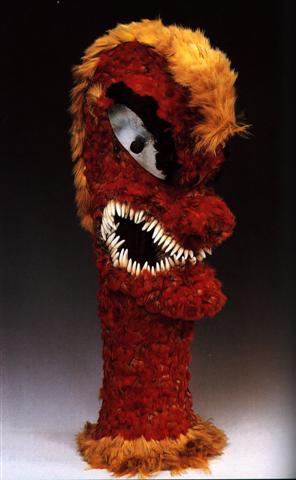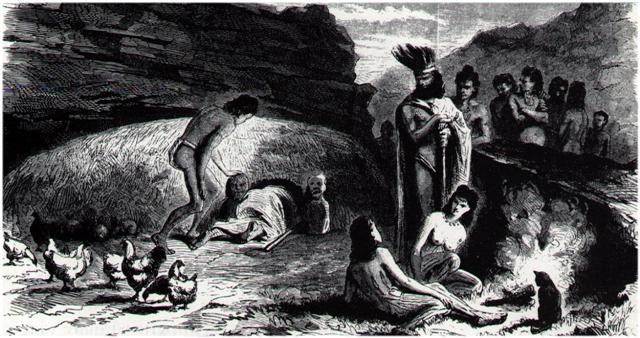|
TRANSLATIONS
We
have established a new pattern
for the 42 glyphs beyond Aa1-48
and it is worth documenting in a
table:
|
cardinal |
Aa1-49--54 |
 |
 |
6 |
42 |
|
sun present |
Aa1-55--60 |
 |
1 |
 |
6 |
6 |
18 |
|
Aa1-61--66 |
 |
7 |
 |
12 |
6 |
|
Aa1-67--72 |
 |
13 |
 |
18 |
6 |
|
sun absent |
Aa1-73--78 |
 |
19 |
 |
24 |
6 |
18 |
|
Aa1-79--84 |
 |
25 |
 |
30 |
6 |
|
Aa1-85--90 |
 |
31 |
 |
36 |
6 |
Aa1-60 presumably
is a picture of sun bursting
forth from the old 'bud', it has emerged out from the
cardinal darkness. Aa1-66 and
Aa1-72 indicate with feather
marks how sun is present. In
Aa1-78 and Aa1-84, on the other
hand, we have Metoro's
inoino glyphs. We should
remember how at sun-mit, in
Aa4-69, such a glyph also
appears (the first one beyond
Aa1-84). A Rei introduces
the inoino season and we
recapitulate some of the ideas
earlier presented:
|

|

|

|

|

|
 |

|

|
 |
|
Aa4-64 |
Aa4-65 |
Aa4-66 |
Aa4-67 |
Aa4-68 |
Aa4-69 |
Aa4-70 |
Aa4-71 |
Aa4-72 |
|
314 |
315 |
316 |
317 |
318 |
319 |
320 |
321 |
322 |
|
0 |
1 |
2 |
3 |
4 |
5 |
6 |
7 |
8 |
|
|
...
The year was
anciently two
'years' (half-years
or periods somewhat
shorter due to the
invisibility of the
Pleiades or other
stars). Therefore
taku-rua (ta'u-rua,
tau-rua, two
'stones'), the
foundation of the
system of balls and
rhombs.
Triple 'stones' with
a 'notch' would be a
good picture for the
Belt of Orion, a
marker for new year.
The three islets
outside Orongo would
be connected with
the Belt of Orion
and with the
beginning of a new
year.
Triple rhombs would
serve as the
opposite side of the
year, when sun ruled
over the land. At
night (winter) new
year is inaugurated
by admiring Orion
(or the Pleiades),
while the changing
status of the sun is
only to be seen in
the daytime ... |
|
...
Rhomb glyphs (as a
rule) are not
located among the
glyphs in the first
half of respective
side. A new table
summarizes the exact
figures:
|
number
of rhomb
glyphs |
|
line no. |
side b |
side a |
line no. |
side b |
side a |
|
1 |
- |
2 |
5 |
12 |
1 |
|
2 |
1 |
1 |
6 |
14 |
1 |
|
3 |
1 |
- |
7 |
2 |
- |
|
4 |
- |
2 |
8 |
- |
1 |
|
sum |
2 |
5 |
sum |
28 |
3 |
The
red-marked numbers
(for the 2nd half of
side b) do not look
random and appear to
be a result of the
design of the
creator ... |
|

|

|

|

|

|
|
Aa4-63 |
Aa4-64 |
Aa4-65 |
Aa4-66 |
Aa4-67 |
|
i to rei
- kua
hua ia |
kua hura
i te
ragi |
ko te
manu kua
moe |
ki to
ihe |
e kua
puhi ki
te ahi |
|

|

|

|

|

|
|
Aa4-68 |
Aa4-69 |
Aa4-70 |
Aa4-71 |
Aa4-72 |
|
o te
nuahine
- mau i
te rei |
ko te
matariki |
e hau
tea - e
hapai
ana koe |
i te
maitaki
- ko
matou
hanau |
|
|
... The
low
entrances
of
houses
were
guarded
by
images
of wood
or of
bark
cloth,
representing
lizards
or
rarely
crayfish.
The bark
cloth
images
were
made
over
frames
of reed,
and were
called
manu-uru,
a name
given
also to
kites,
masks,
and
masked
people
...
A kite
(like a
mask) is
not the
real
thing,
it is
manu-uru
(a
fake).
If
Mangaians
flew a
diamond-shaped
kite
representing
the
Pleiades,
then the
Pleiades
were
probably
not
seen,
and
flying a
substitute
was
presumably
an act
of
sympathetic
magic to
make
them
return
again to
the
skies. |
|
... He
was also
a great
kite-flier,
and the
story is
told of
a small
boy of
another
name
(but it
could
only
have
been
Maui)
who once
came
half out
of the
water
and
snatched
the
kite-string
of a
child on
the
land. He
then
slipped
back
into the
sea and
continued
flying
it from
under
the
water
until
his
mother
was
fetched,
for she
was the
only one
who
could
control
him and
make him
behave
at that
time ...
If
Maui
flew a
kite
from
below
(sea)
water,
then the
season
must
have
been
winter,
I think. |
|
... The
Sun
spends
part of
the year
with the
Winter
Maid in
the
south,
afar out
on the
ocean.
In the
month of
June
occurs
the
changing
of the
Sun and
he
slowly
returns
to his
other
wife, to
the
Summer
Maid who
dwells
on land
and
whose
other
name is
Aroaro-a-manu.
This
period
we call
summer.
And so
acts the
Sun in
all the
years
...
Sun is
changing
in June
(and
therefore
also in
December).
He
slowly
returns
to his
Summer
Maid who
dwells
on land
and who
is
called
Aroaro-a-manu,
'the
face,
belly,
front
side of
the
(sun)
bird'.
It is
not
stated
that
summer
starts
at
winter
solstice.
Summer
maybe
starts
at
spring
equinox.
If the
Pleiades
appear
at
winter
solstice
and
disappear
at
summer
solstice,
those
two
periods
presumably
do not
coincide
with
'summer'
respectively
'winter'. |
|
Aa1-67 is located as the 1st
glyph in the 3rd and last
subgroup of the 1st half of the
36-glyph long sequence, number
13 of the 36 glyphs. In H its parallel
glyph is Ha6-124 which, like
Aa1-67 is preceded by a henua
type of glyph:
|
 |
 |
 |
 |
 |
 |
 |
 |
|
Ha6-120 |
Ha6-121 |
Ha6-122 |
Ha6-123 |
Ha6-124 |
Ha6-125 |
Ha6-126 |
Ha6-127 |
|
*Ha6-45 |
*Ha6-46 |
*Ha6-47 |
*Ha6-48 |
*Ha6-49 |
*Ha6-50 |
*Ha6-51 |
*Ha6-52 |
|
7 glyphs
(Ha6-128--134) |
 |
 |
 |
 |
 |
|
Ha6-135 |
Ha6-136 |
Ha6-137 |
Ha6-138 |
Ha6-139 |
|
*Ha6-60 |
*Ha6-61 |
*Ha6-62 |
*Ha6-63 |
*Ha6-64 |
It
is not possible to divide 85 -
48 = 37 glyphs in 6-glyph
groups. Maybe 19 (at Aa2-67) +
18 = 37 is the key?
I
have red-marked the three
tagata glyphs, two flanking
Aa2-52 and one at Aa2-59.
Possibly we should move both
Aa2-53 and Aa2-59 to the groups
immediately before. Manipulating
this change it seems reasonable
to also shift Aa2-49 to the
preceding group, which results
in a pattern with 5 + 6 + 7 = 18
glyphs:
Here I have red-marked the
obviously related haú
glyphs (with ordinal numbers 10
respectively 11 times 5), while
the 5 green-marked glyphs seem
to be related to judge from
the marks.
I have arranged
the three groups so that vai
in Aa2-37 arrives as the last
glyph in the first subgroup (in
harmony with how vai in
Aa2-54 arrives as the last glyph
in the first subgroup).
Secondly,
blackmarked mauga in
Aa2-32 and Aa2-38 (probably
signifying darkness and the
opposite to the feathermarked
haú glyphs) arrive as the first
glyphs in the two first subgroups.
The number of
glyphs will therefore be 6 + 7 +
5 = 18, a confirmatory result.
Once again we reach the
conclusion that darkness rules
the first triplet of hatchmarked
henua, while the second
triplet is associated with its
opposite, light.
We
can, rather confidently,
red-mark the 5 glyphs at
(presumably)
midsummer:
 |
 |
 |
 |
 |
|
Aa2-50 |
Aa2-51 |
Aa2-52 |
Aa2-53 |
Aa2-54 |
Aa2-54 is - according
to what is documented at
vai in the glyph
dictionary - a symbol for
sun being present.
Aa2-51 and Aa2-53 are -
according to what is
documented at tagata in the
glyph dictionary -
symbolizing the fully grown
'person', useful for marking
summer solstice.
Aa2-50 is - according to my
preliminary documentation in
the first pages at haú
in the glyph dictionary - a
picture including feathers
(the marks), which surely
must symbolize 'fire':
|
A few
preliminary
remarks and
imaginations:
1.
Let us consider
what the small
marks around the
outer perimeter
of this 'bent
bough' might
mean. The word
haú - if
a correct
reading by
Metoro -
implies that the
glyph type
illustrates some
kind of 'hat',
haú,
maybe
constructed by
fibres, hau,
from the
hauhau tree.
These old
pictures from
China (Needham
2) have similar
marks and they
mean feathers:

More to the
point, in Hawaii
we find
feathered gods:
"In many
Polynesian
cultures the
bodies of gods
were conceived
of as covered
with feathers
and they were
frequently
associated with
birds: in Tahiti
and the Society
Islands, bird
calls on the
marae
signaled the
presence of the
gods. Hawaiian
feathered god
figures
generally depict
only the head
and neck of the
god." (D'Alleva)

|
|
2. In
Heyerdahl 6 we
find a picture
of bark cloth
from Mexico with
a design
(bottom) very
much like the
GD19 type of
glyphs, though
reversed:

... Handy (1930
c, p. 24) ...
emphasizes that
certain
Polynesian
traits, such as
the 'ceremonial
and ornamental
use of feathers
... find their
parallels in
America rather
than west of
Polynesia.'
An old
drawing
(curiously
incorporating a
newly arrived
immigrant, the
cat) illustrates
the entrance to
a hare paega
(a peculiar
Easter Island
house resembling
an overturned
canoe):

(Drawn 1872 by
Pierre Loti,
according to
Heyerdahl.)
At center
right we can see
a standing
person, probably
a chief, with a
feathered
headdress.
Glyphs of the
GD63 type,
mostly referred
to as ariki
(chief) by
Metoro, are
often designed
with what
presumably is a
head gear with
feathers.
Examples:
|
|















































